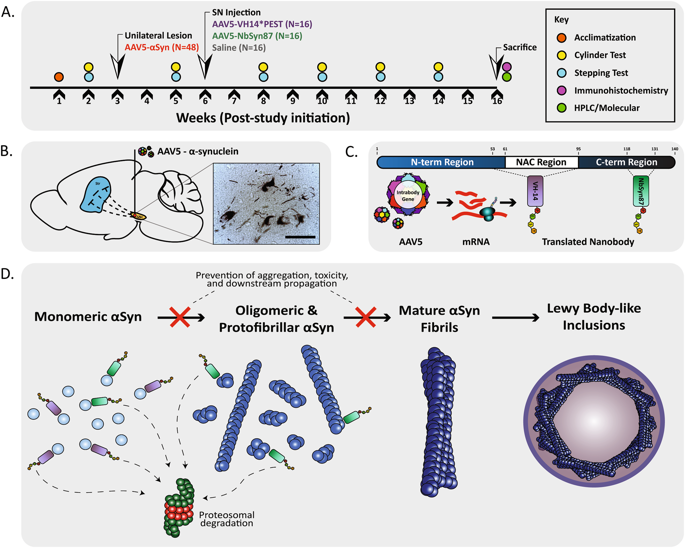npj Parkinson's Disease ( IF 9.304 ) Pub Date : 2018-08-22 , DOI: 10.1038/s41531-018-0062-4 Diptaman Chatterjee , Mansi Bhatt , David Butler , Erwin De Genst , Christopher M. Dobson , Anne Messer , Jeffrey H. Kordower

|
Therapeutics designed to target α-synuclein (α-syn) aggregation may be critical in halting the progression of pathology in Parkinson’s disease (PD) patients. Nanobodies are single-domain antibody fragments that bind with antibody specificity, but allow readier genetic engineering and delivery. When expressed intracellularly as intrabodies, anti-α-syn nanobodies fused to a proteasome-targeting proline, aspartate or glutamate, serine, and threonine (PEST) motif can modulate monomeric concentrations of target proteins. Here we aimed to validate and compare the in vivo therapeutic potential of gene therapy delivery of two proteasome-directed nanobodies selectively targeting α-syn in a synuclein overexpression-based PD model: VH14*PEST (non-amyloid component region) and NbSyn87*PEST (C-terminal region). Stereotaxic injections of adeno-associated viral 5-α-syn (AAV5-α-syn) into the substantia nigra (SN) were performed in Sprague–Dawley rats that were sorted into three cohorts based on pre-operative behavioral testing. Rats were treated with unilateral SN injections of vectors for VH14*PEST, NbSyn87*PEST, or injected with saline 3 weeks post lesion. Post-mortem assessments of the SN showed that both nanobodies markedly reduced the level of phosphorylated Serine-129 α-syn labeling relative to saline-treated animals. VH14*PEST showed considerable maintenance of striatal dopaminergic tone in comparison to saline-treated and NbSyn87*PEST-treated animals as measured by tyrosine hydroxylase immunoreactivity (optical density), DAT immunoreactivity (optical density), and dopamine concentration (high-performance liquid chromatography). Microglial accumulation and inflammatory response, assessed by stereological counts of Iba-1-labeled cells, was modestly increased in NbSyn87*PEST-injected rats but not in VH14*PEST-treated or saline-treated animals. Modest behavioral rescue was also observed, although there was pronounced variability among individual animals. These data validate in vivo therapeutic efficacy of vector-delivered intracellular nanobodies targeting α-syn misfolding and aggregation in synucleinopathies such as PD.
中文翻译:

蛋白酶体靶向的纳米抗体可缓解基于α-突触核蛋白的帕金森氏病模型的病理学和功能衰退
设计用于靶向α-突触核蛋白(α-syn)聚集的治疗药物可能对于阻止帕金森氏病(PD)患者的病理进展至关重要。纳米抗体是与抗体特异性结合的单域抗体片段,但允许更容易的基因工程和递送。当在细胞内表达为体内抗体时,与靶向蛋白酶体的脯氨酸,天冬氨酸或谷氨酸,丝氨酸和苏氨酸(PEST)基序融合的抗α-syn纳米抗体可以调节靶蛋白的单体浓度。在这里,我们旨在验证和比较基于突触核蛋白过表达的PD模型中选择性靶向α-syn的两种蛋白酶体定向纳米抗体的基因治疗递送的体内治疗潜力:VH14 * PEST(非淀粉样蛋白区域)和NbSyn87 * PEST (C末端区域)。在Sprague-Dawley大鼠中,根据术前行为测试将腺相关病毒5-α-syn(AAV5-α-syn)立体定向注射到黑质(SN)中。用单侧SN注射VH14 * PEST,NbSyn87 * PEST的载体治疗大鼠,或在病变后3周注射生理盐水。SN的事后评估显示,相对于盐水处理的动物,两个纳米抗体均显着降低了磷酸化的Serine-129α-syn标记的水平。通过酪氨酸羟化酶免疫反应性(光学密度),DAT免疫反应性(光学密度)和多巴胺浓度(高效液相色谱法)测量,与盐水处理和NbSyn87 * PEST处理的动物相比,VH14 * PEST显示出相当程度的纹状体多巴胺能维持)。通过Iba-1标记细胞的立体计数评估的小胶质细胞蓄积和炎症反应在注射NbSyn87 * PEST的大鼠中有所增加,但在VH14 * PEST处理或盐水处理的动物中则没有。尽管个体动物之间存在明显的变异性,但也观察到适度的行为挽救。这些数据证实了针对诸如PD的突触核蛋白病中的α-syn错误折叠和聚集的载体递送的细胞内纳米抗体的体内治疗功效。



























 京公网安备 11010802027423号
京公网安备 11010802027423号